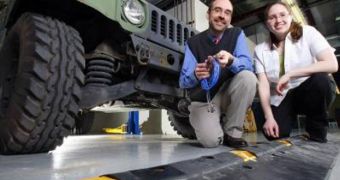Researchers at the Purdue University Center for Systems Integrity (CSI) have just recently finished developing a new diagnostic tool, meant to help the US Army reduce its high operating and maintenance costs. The way they did that was by creating a speed bump-like cleat, a device filled with sensors that can assess the state of a vehicle's suspension when it passes over. The innovation will also reduce downtime for the motor pool, experts say, as it will be able to detect potential malfunctions even before they occur.
“Our aim is to save time and maintenance costs, but more importantly to reduce downtime by catching damage before it leads to failure in the field. Let's say one of the tires is severely under pressure. The cleat tells you to turn around and fill up that tire because you are about to embark on a 10-hour mission with this vehicle. Or, you are returning the vehicle to the depot and the cleat tells you that the right rear suspension has a problem in the shock absorber or a critical bolt in the front suspension is broken. The maintenance personnel don't have to troubleshoot the vehicle. They know what to fix,” Purdue Associate Professor of Mechanical Engineering Douglas Adams, who is also the director of CSI, explained.
The new system, which was a product of a collaboration between the Purdue University, the US Army, and Honeywell International Inc., looks approximately like a speed bump, but its surface is covered in a special type of rubber, laden with sensors called triaxial accelerometers. They are able to identify malfunctions or areas that may soon break, by assessing the way the vehicle that passes over them transmits vibrations through the sensors.
It can identify flaws in tires, wheel bearings and suspension components, and an onboard computer is in charge of translating the readings into messages for the motor pool mechanics.
“The diagnostic cleat is designed to be quick and easy to use. The last thing we want to do is take time from already overburdened soldiers and maintenance officers. The cleat is a quick first check to determine what's mechanically wrong with a vehicle before wasting time hunting for potentially simple problems. In theater, some vehicles may be used at checkpoints while others may be hauling supplies hundreds of miles. Even if the same vehicle variant is used, they are on very different missions and trying to use the same regular maintenance schedule for both isn't always efficient or effective,” the leader of the US Army center modeling and simulation team, Joseph Gothamy, added.
“Our simulated model showed us that we were capable of using the system accurately to detect damage to vehicle components, and our experiments with actual vehicles validated the model. The system was sensitive to as little as a 5 percent change in the stiffness of the suspension. This system is currently ready to acquire more data in Army depots, and we are working with the Tank Automotive Research, Development and Engineering Center to start a large vehicle survey exercise with vehicles coming back from overseas. Data will be used to determine the types of wear and tear exhibited by vehicles deployed in certain terrains,” Adams concluded.

 14 DAY TRIAL //
14 DAY TRIAL //